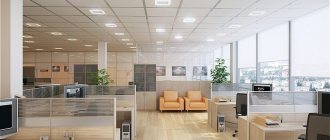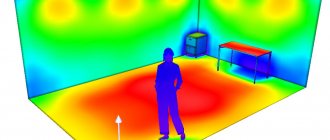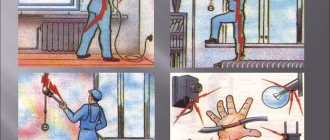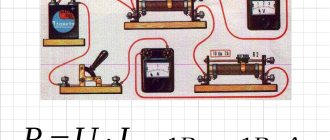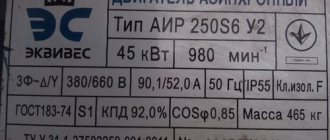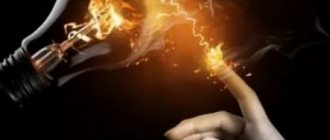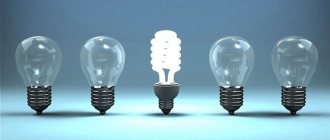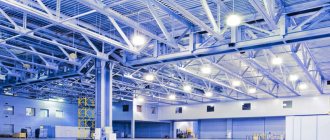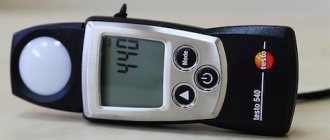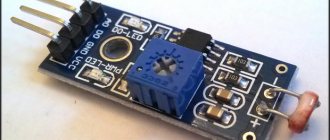How to measure ripple factor?
Experiments have confirmed that light inevitably affects our well-being. Low lighting in the workplace is a common cause of health problems, decreased concentration, mental problems, and decreased performance.
Excessively bright light, on the contrary, is an irritant and can cause stress.
The best solution is to provide the right lighting to ensure optimal performance.
Normal lighting levels are clearly regulated for each type of premises. These parameters have their own rules and regulations that you need to know about.
In this case, the sanitary-epidemiological service assumes the control function.
Creating visual comfort in the workplace
The fact that light and color affect labor productivity and the psycho-physiological state of the worker should stimulate the interest of lighting specialists, physiologists and ergonomists in studying and determining the most favorable conditions of light and color in each workplace. The combination of lighting, the contrast of brightness, the color of light, and the choice of color are the elements that determine visual comfort.
The most important energy
Of all the types of energy that people can use, light is the most important. It is a key element of our ability to see, as we need to evaluate the shape, color and perspective of objects around us in everyday life. Most of the information we receive through our senses comes to us through light (about 80%).
However, we must not forget that the degree of fatigue depends on the lighting and color of surrounding objects. From an occupational safety point of view, visual ability and visual comfort are extremely important. This is because many accidents occur due to poor lighting or due to mistakes made by the worker because it was difficult to recognize an object or understand the degree of risk associated with servicing machines, vehicles, containers.
For your information. Visual impairment due to deficiencies in the lighting system is a common occurrence in the workplace these days. Due to the ability of vision to adapt to low light, this is sometimes not taken as seriously as it should.
The correct lighting system should provide optimal conditions for visual comfort. To achieve this goal, communication between architects, lighting designers and industrial hygiene specialists must be established at a very early stage of the work. This collaboration should precede the start of work on the project to avoid making mistakes that will be difficult to correct after the project is completed.
Factors that determine visual comfort and influence the visibility of objects
In order to provide the conditions necessary for visual comfort, the lighting system must meet the following requirements:
- uniform lighting;
- optimal brightness;
- no glare;
- appropriate contrast;
- correct color scheme;
- no stroboscopic effect or flicker of light.
Light in the workplace should include components of both diffuse and direct radiation. The result of this combination should be shadow formation of greater or lesser intensity, which should allow the worker to correctly perceive the shape and position of objects in the workplace. Annoying reflections that make it difficult to see detail should be eliminated, as should overly bright lights or deep shadows.
Periodic maintenance of the lighting installation is of great importance - preventing the aging of lamps and the concentration of dust on the lamps. It is important to choose lamps and lighting systems based on their ease of maintenance. An incandescent lamp remains effective until it fails, but this is not the case with fluorescent lamps, as their light output can drop by up to 75% after thousands of hours of operation.
The degree of safety with which work is carried out depends to a large extent on the quality of lighting and visual abilities. The brightness of the object, its surroundings, and the work area affects the ease with which the object is visible. Therefore, a thorough analysis of the area where the work is being carried out is of paramount importance.
The time period over which visual perception of an object occurs and the ability of the eye to adjust to different illumination of objects can also have a significant impact on visibility.
Light levels
Each activity requires a certain level of illumination. Typically, the more visual impairment is present, the higher the average illumination level should be. Standards for minimum illumination levels associated with the performance of various works are reflected in SanPiN 2.2.1/2.1.1.1278-03 “Hygienic requirements for natural, artificial and combined lighting of residential and public buildings” (approved by the Chief State Sanitary Doctor of the Russian Federation on 04/06/2003 ), SNiP 23-05-95 “Natural and artificial lighting” (approved by Order of the Ministry of Regional Development of Russia dated December 27, 2010 No. 783).
The level of illumination is measured using a lux meter, which converts light energy into an electrical signal, which is then amplified and easily read on a scale graduated in lux. When choosing a certain level of illumination for a particular workplace, the following characteristics must be taken into account:
- nature of the work;
- reflectivity of the object of work and the immediate environment;
- difference with natural light and the need for daylight;
- worker's age.
Units and values of illumination
The main illumination values are the following:
- Light flow. Light energy emitted per unit time by a light source. Unit of measurement: lumen (lm).
- The power of light. Luminous flux emitted in a given direction by unevenly distributed light. Unit: candela (cd)
- Light level. The illumination level is 1 m2 of surface, onto which a luminous flux of one lumen falls. Unit of measurement: lux = lm/m2.
- Luminance, or photometric brightness. Determined for a surface in a certain direction and is the ratio of the luminous intensity to the surface as seen by an observer in the same direction (apparent area). Unit of measurement: cd/m2.
- Contrast. The difference in brightness between an object and its surroundings, or between different parts of an object.
- Reflection coefficient. The proportion of light reflected by a surface. This is a dimensionless quantity. Its values are between 0 and 1.
What causes eye strain?
The key factors in conditions affecting vision are light distribution and brightness contrast. Regarding light distribution, it is preferable to have good general lighting instead of local lighting in order to avoid glare. For this reason, electrical appliances should be distributed as evenly as possible to avoid differences in light intensity. Constantly moving around in unevenly lit areas tires the eyes, and over time this can lead to decreased visual acuity.
Glare occurs when a bright light source is in the field of view; its result is a decrease in the ability to distinguish objects. Workers who are constantly exposed to blindness may suffer from eye strain as well as functional impairment, although they are often unaware of it.
Glare can be direct, when it is caused by bright light sources in the field of view, or reflected, when light is reflected from highly reflective surfaces. Glare is affected by the brightness of the light source (the maximum tolerable brightness for direct viewing is 7500 cd/m) and the location of the light source (if the light source is within a 45 degree angle to the line of sight), the distribution of brightness among various objects and surfaces (the more the difference in brightness among objects in the field of view, the greater the glare will be) and the time period of visual perception of the object (even light sources with low brightness can cause glare if visual perception lasts too long).
How to avoid being blinded. There are several ways to do this. One way, for example, is to install grids under light sources; You can also use wraparound diffusers or parabolic reflectors, which can direct the light where you want it, or position the light sources so that they are out of sight.
Types of lighting systems
Currently, interest in natural lighting has increased. This is caused not so much by the quality of this lighting, but by the feeling of comfort it gives. But lighting from natural sources is not uniform; the use of an artificial lighting system is required.
The most common lighting systems are the following:
- General uniform lighting. Light sources are distributed evenly without taking into account the location of workplaces. They are used mainly in areas where workplaces are not stationary.
Such a system must meet three requirements: equipped with anti-glare devices (grids, diffusers, reflectors, etc.), part of the light must be directed to the ceiling and the top of the walls, light sources must be installed as high as possible to reduce glare to minimum and make the lighting as uniform as possible
- Local lighting and general lighting. This system attempts to enhance the overall lighting scheme by placing lamps closer to work surfaces. These types of lamps often produce glare, and reflectors should be positioned so that they remove the light source from the worker's direct field of vision. The use of local lighting is recommended where visual requirements are very high: lighting levels of the order of 1000 lux or higher. Typically, as a worker ages, his visual ability decreases, which requires that the level of general lighting be increased or that it be enhanced by local lighting.
- General local lighting. Ceiling sources placed taking into account the characteristics of the lighting equipment and the lighting needs of each workplace. Recommended for spaces or work areas where high levels of lighting are required.
Lamp categories
Choosing the right color for your workplace will go a long way toward improving worker productivity, safety, and overall well-being.
Lamps are divided into three categories depending on the color of light they emit:
- warm color: white-reddish, recommended for lighting residential areas;
- intermediate color: white light is recommended for illuminating work areas;
- cool color: white bluish is recommended for work that requires high levels of light or for hot climates.
The color of light, its distribution and the colors that exist in a given space are, among other things, key factors influencing the human experience. Since there are so many colors and comfort factors, it is impossible to establish exact standards here, especially taking into account the fact that all these factors must be used comprehensively, in accordance with the characteristics of a particular workplace and the requirements placed on it. However, here we can give a list of basic and general rules that can help create a favorable environment:
- Bright colors promote feelings of comfort, activity and calm, while dark colors have a depressing effect.
- Warm-colored light sources work well to reproduce warm colors. Objects painted in warm colors are more pleasing to the eye in warm light than in cold light.
- Pure and dull colors (like pastels) are appropriate as background colors, while the actual objects should have rich and saturated colors.
- Warm colors excite the nervous system and give a feeling of rising temperature.
- Cool colors are preferred for items. They have a calming effect and can be used to create a curvature effect, helping to create the feeling of a drop in temperature.
- Through color you can also influence the spatial perception of the room. A room appears to have a low ceiling if its walls are painted a bright color and the floor and ceiling are darker; a room appears to have a high ceiling if the walls are darker and the ceiling is bright.
Combination and selection of colors
The choice of color is very relevant when we consider it in conjunction with an activity where identifying the objects to be worked with is important.
The surface of the ceiling should be as white as possible (with a reflectance of 75%), because then the light will be reflected from it in a diffuse form, in turn dissipating the darkness and reducing glare from other surfaces. This will also help save artificial lighting.
Wall surfaces at eye level may cause glare. Pale colors with a reflectance of 50 to 75% are more suitable for walls. Although glossy paints last longer than matte paints, they have a higher reflectivity. Therefore, the walls should be painted with matte or semi-gloss paint.
Floors should be slightly darker than walls and ceilings to prevent glare. The reflectance of floors should be between 20 and 25%.
Work surfaces, machines and tables should have a reflectance of 20 to 40%. The equipment must be coated with a durable, clear coat of paint, light brown or gray, that is not shiny.
There is a common belief that painting walls and ceilings white and providing adequate levels of lighting can be done to ensure workers' visual comfort. But this comfort level can be improved by combining white with other colors, thereby avoiding the fatigue associated with a monochromatic environment.
The correct selection of colors for the work environment contributes to better organization of work and the prevention of accidents.
Recognizing objects using color
Color plays a key role in recognizing objects. We can use bright and eye-catching colors or color contrasts to highlight items that require special attention.
Moreover, identification using color should be used only when it is really necessary.
- Fire-fighting equipment. In order to quickly find it, it is recommended to hang a conspicuous diagram on the nearest wall.
- Production equipment. Painting stopping or emergency devices in bright colors is an urgent requirement. It is also recommended to mark with paint areas that need lubrication or periodic maintenance.
- Pipelines and pipes. If they are important or intended to transport hazardous substances, then the best advice is to paint them completely. In some cases, it will be enough to paint a line along their entire length.
- Stairs. In order to make the descent easier, it is preferable to paint one stripe on the march instead of several.
- Dangers. Danger should be marked with color only where danger exists constantly. This designation will be more effective if it is done in accordance with a pre-established conventional coloring.
Indoor illumination: how is it measured?
The nominal illumination of a room in numerical terms is the luminous flux that falls on a plane at an angle of 90 degrees per unit area.
If the light falls at an acute angle, then the illumination parameter will change.
The resulting indicator will decrease in direct proportion to the angle mentioned above.
The unit of illumination level measurement is lux. In this case, one lux is equal to one unit of luminous flux (lumen) per square meter.
If we consider a physical unit system, then the unit of measurement of illumination is phot. In this case, 1 photo = 10,000 lux.
The illumination parameter will change in proportion to the intensity of light emanating from the source itself. The further away the illuminated object is, the lower its illumination.
For example, in the USA and England the unit of illumination is different. There it is customary to use the “foot-candle”. This setting represents that the light intensity that is equal to one candela illuminates an object one foot away from the light source.
In theory, several other types of units of measurement are used, but, as a rule, they are outdated, not recognized by the international system, or are simply derivatives of the main parameter (lux).
Correlation of various parameters
High quality lighting is ensured by a combination of a number of qualitative and quantitative indicators. These include:
- Light flow.
- The power of light.
- Brightness of light.
- Surface reflectance.
- General office illumination.
- Ripple coefficient of lamps.
- Indicators of blindness and discomfort.
- Volume and color rendition.
During the day, the number, size and location of windows play an important role.
Measuring room illumination: basic methods and instruments
To determine the level of illumination, you can use one of the following devices - flash meter, exposure meter and light meter, lux meter or photometer.
The main device from this group, capable of displaying the real illumination parameter (natural or artificial) is a lux meter.
They are analog and electronic. Analog devices are no longer produced, only rarities remain.
It can be used to solve the following problems:
- measuring lighting levels during certification (inspection) of workplaces;
- taking illumination indicators and comparing them with calculated parameters when performing work on the installation of lighting elements;
- monitoring compliance of the level of illumination in certain premises with current standards;
- analysis of illumination parameters for compliance with design parameters during the period of installation of lighting elements.
The light meter itself works on a simple principle. A photocell is built inside the device. When a light beam is directed at it, a powerful flow of electrons is released inside the semiconductor element.
The result is the appearance of an electric current. The magnitude of the latter is proportional to the strength of the light that illuminates the photocell of the device.
As a rule, it is this parameter that is reflected on the instrument scale.
Depending on the type of fixation of the control element (sensor), the lux meter is of two types:
- rigid fixation of the sensor (performed in the form of a solid device, monoblock);
- with a remote-type sensor, which is connected using a flexible cable.
To carry out simple measurements, the simplest device is enough - a lux meter in the form of a monoblock, without additional options.
If you need to clarify a larger number of parameters when conducting professional research, then it is better to use more complex devices - with the option of calculating the average parameter and built-in memory.
A big plus is the use of special light filters in the luxmeter. With their help, you can more accurately calculate the luminous intensity parameter coming from lighting fixtures with different shades of color.
In addition, devices with a remote sensor show greater measurement accuracy, because they are less affected by external factors.
In turn, the presence of an LCD display on modern models greatly simplifies the process of taking readings from the device.
Instruments such as exposure meters and exposure meters are used in photographic equipment.
Their task is to record the parameters of exposure illumination and brightness. Knowing the value of these indicators, the photographer can achieve ideal photo quality.
In turn, exposure meters are available in two types. They are external and internal.
The task of a flash meter is to measure the level of illumination during the photography process. Pulse-type lighting devices are used as auxiliary elements.
New cameras already have a built-in flash meter. Its task is to regulate the power of the flash depending on the lighting level.
Order of conduct
To organize such a check at an enterprise or company, you need to enter into an agreement with an organization that has the right to conduct light measurements. Next, select the date for the measurements.
On the appointed day, a specialist goes to the organization with all the necessary equipment and takes measurements. A responsible employee of the company, appointed by order of the manager, must be present during the procedure. Based on the results of the procedure, a protocol of illumination measurements and a conclusion are drawn up. Documents can be issued for each premises or for the entire facility.
For your information! Measurements are carried out with a lux meter - a mobile portable device. Measurements are carried out using artificial and natural lighting.
Illumination pulsation coefficient: essence and norms
It is no secret that all lighting devices emit an uneven luminous flux, having a different number of vibrations. This effect is hidden from view, but its effect on human health is very significant.
At the same time, the danger of light lies precisely in the fact that it cannot be recognized, but the result of the action can be sleep disturbance, weakness, depression, heart failure, discomfort, and so on.
Lighting pulsation coefficient is a parameter that reflects the force of change in the luminous flux directed per unit surface in a certain time period.
The coefficient is calculated using a simple formula - the maximum illumination parameter in a certain period of time “minus” the minimum indicator for the same period of time.
The resulting number must be divided by the average illumination parameter and multiplied by 100%.
It is worth considering that existing sanitary rules set an upper limit on the pulsation coefficient parameter.
Where the workplace is organized it should not be higher than 20%. Moreover, the more responsible the employee’s type of activity, the lower this parameter should be.
So, for office premises and administrative buildings, where intense visual work is involved, the pulsation coefficient should not be more than 5%.
In this case, the light flux with pulsations up to 300 Hz is taken into account, because a higher frequency parameter is simply not perceived by the human body and cannot have any effect on it.
Types of lighting and its standards
Based on the source, types of lighting are divided into natural and artificial. Natural light in an office space is sunlight that comes through the windows. It is considered ideal for human vision, but it is not always sufficient and is also difficult to adjust.
The basis of industrial lighting is artificial light provided by lamps. In winter it is turned on for most of the working day; in summer it is needed in the mornings and evenings or as a supplement to natural light. Installation of lamps, their rationing, selection of light sources is entirely the responsibility of the employer.
Daylight
It is difficult to make sunlight meet sanitary requirements. However, the size of the windows, the location of the tables relative to the windows, and the presence of curtains and blinds are regulated. Employees' workstations should be located sideways to the window, so that the light falls from the right or left.
Important! It is strictly forbidden to place tables facing the window - then the employee will have to look at the monitor against the light. To protect from the bright rays of the sun, blinds are used.
Ripple coefficient: measurement features
To determine the frequency of lighting pulsation, you can use a simple and effective device - an illumination, pulsation and brightness meter.
Its functionality allows you to determine:
- brightness level of monitors and artificial lighting devices;
- room illumination level;
- pulsations of illumination of all types of monitors;
- pulsations of light waves that appear when different lamps flicker.
The operating principle of the main group of devices (pulse meter, brightness meter and lux meter) is to control the light level using a photosensor, after which the signal is converted and the result can be seen on the LCD display.
Luxmeter-Pulsemeter-Brightness meter Ecolight-02.
To determine the pulsation coefficient, you can go in two ways - conduct an independent analysis or use a computer program.
The most popular devices for calculating pulsations are “Ecolight - 01 (02)” and “Lupin”. If you need to analyze data on a computer, you can use special software - Ecolight-AP.
The main difference between devices for measuring pulsations is the quality of photocells, the type of power sources (batteries) and the level of sensitivity.
LED lamps have the maximum pulsation coefficient (sometimes this parameter can reach 100%). Incandescent and fluorescent lamps have a lower ripple factor.
For example, the former have a pulsation coefficient of no more than 25%. At the same time, the quality and price of the light source are not important, because even expensive lamps can have a high pulsation coefficient.
Illumination standards
Today, each type of room has its own standard of illumination, as well as maximum permissible pulsation coefficients.
For example, for a sales area in a grocery store, the maximum pulsation coefficient parameter is 15%, and the illumination level is 300 lux, for the department of building materials, sporting goods and plumbing - 10% and 200 lux, for the kitchenware department, toy and clothing store - 20% and 200 lux, for fitting rooms - 20% and 300 lux and so on.
Accordingly, there are specific lighting standards for kindergartens, residential premises, medical institutions, car washes, and so on.
Further, all lighting standards are displayed in tables.
Read on the topic: How to find out the level of illumination in rooms.
What information is contained in the light measurement protocol
The company conducting the measurements draws up the protocol form independently. The document will need to provide the following information:
- The name of the organization that conducts the inspection and its details (legal address, telephone number, tax identification number, checkpoint, information about the accreditation certificate or other documents permitting activities).
- The name of the document, its number and date of preparation.
- Date and time of illumination measurements.
- Place of illumination measurements (address and name of the institution).
- Basis for taking measurements: agreement with the institution. You will also need to provide his details.
- Premises where the inspection was carried out: offices, workshops, etc.
- Additional Information. You can indicate what voltage was in the network, what kind of lighting was in the room, whether there was furniture there, etc.
- Full name and position of the employee who carried out the measurements.
- Full name and position of the responsible employee in whose presence the measurements were taken.
- Name of measuring instruments and data on their verification.
- Regulatory and technical documentation according to which measurements were carried out and a conclusion was given.
- Illumination measurement results. This item can be presented in the form of a table with the following columns: serial number, location of measurements, category of visual work, lighting system (types of lamps), measured illumination, permissible illumination.
At the end of the document, the employee who carried out the measurements and filled out the protocol, and the employee of the institution where the inspection was carried out, must sign.
The protocol is also accompanied by an expert’s opinion on the state of illumination in the institution, and a diagram of the location of illumination measurement points.
How to reduce lighting pulsation?
In recent years, increasing importance has been given to the control of pulsation emanating from lighting sources.
If these parameters are overestimated, all measures are taken to normalize (reduce) them.
This is implemented using one of the following methods:
- Using lighting devices powered by alternating current (frequency must be greater than 400 Hz).
- Installation of a compensating ballast device into the luminaire, as well as connection of offset lamps. The first lamp is characterized by lagging current, and the second - leading.
- Installation of simple lamps on different phases (a three-phase network is required).
- Application of lamps with electronic ballasts.
The choice of one of the options with which you can achieve the optimal ripple coefficient parameter depends on the implementation conditions for each specific case.
